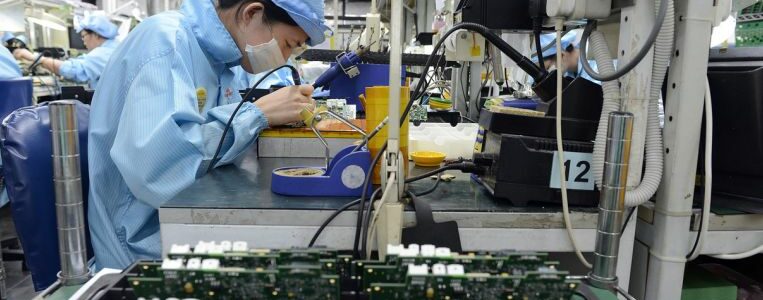
Supply chain disruptions drag on Singapore's factory activity growth
SINGAPORE – Manufacturing activity in Singapore suffered a second month of decline but maintained its expansionary course for the 15th month in a row, thanks to the electronics sector’s continued resilience to a host of challenging supply chain issues.
However, analysts warned that electronics, which accounts for about a quarter of Singapore’s exports, may be nearing a peak in its growth cycle and the sector’s expansion may start to taper off later this year.
September’s Singapore Purchasing Managers’ Index (PMI), a key bellwether of activity in the manufacturing industry, came in at 50.8.
This is0.1 points lower than August, when it posted a drop of the same magnitude, said the Singapore Institute of Purchasing and Materials Management (SIPMM) on Monday (Oct 4).
Economists in a Bloomberg poll had expected the PMI to be unchanged at 50.9.
Overall manufacturing has now recorded 15 months of consecutive expansion, that is, a PMI reading above 50. A reading below the 50 mark reflects contraction.
The electronics sector’s PMI came in at 51.2, rising for a 14th straight month.
The overall manufacturing PMI performance was attributed to slower expansion rates in key sub-indexes for new orders, new exports, factory output, inventory and employment.
However, the indexes for finished goods, input prices and supplier deliveries expanded at a faster rate and the employment index expanded for a seventh month in a row.
“Supply chain disruptions are still plaguing local manufacturers as they struggle to cope with reduced margins from the higher cost pressures,” said Ms Sophia Poh, SIPMM’s vice-president for industry engagement and development.
This was reflected in the input prices index came at 51.7 – the highest recorded since December 2017 when the index was 51.8.
The electronics sector’s stronger reading was attributed to faster growth recorded in new orders, new exports and factory output.
However, the indexes for both inventory and employment expanded at a slower rate, whereas the indexes for imports, input prices, and order backlog expanded at a faster pace.
Meanwhile, the supplier deliveries index reverted to contraction after having recorded eight months of continuous expansion.
The finished goods index also expanded at a slower pace, which could be a harbinger that momentum could have peaked and an imminent slowdown is on the cards.
Ms Selena Ling, OCBC Bank’s chief economist and head of treasury research and strategy, said that as inventory levels edge lower for both the domestic manufacturing and electronics sectors, the ability to sustain production in the run-up to the Christmas season’s demand spike may be at stake.
She said that going forward, companies’ ability to pass on some of the higher costs to end-consumers would also be key to maintaining their growth momentum.
“Fears of supply chain disruptions and component shortages interrupting the manufacturing momentum within Asia appear to pose potential headwinds ahead for regional manufacturing centres including Singapore,” she said.
Manufacturers worldwide, including Singapore’s Creative Technology, have been struggling with challenging market conditions since late last year. These were due to supply chain disruptions caused by the global shortages of semiconductors, delays in shipping schedules due to port congestion and a shortage of containers, and skyrocketing freight costs.
Creative, which once used to compete with Apple Inc for portable media players, said in a regulatory filing in August this year that it expects an operating loss in the financial year the will end in June 30, 2022.
This comes as the company grapples with product shortages due to component unavailability and spiking prices, as well as frequent shipping disruptions.
The supply chain disruptions have further worsened in recent weeks due to ongoing power shortages in China and Covid-related restrictions due to the Delta resurgence across the Asean region.
Analysts said that Chinese policymakers are taking counter measures to address the power shortages, while wider vaccination coverage in Asean which could result in relaxation of restrictions and higher industrial activity. However, near-term supply challenges may persist.
Still, Singapore’s manufacturing sector has so far remained relatively more stable, with industrial production expanding at 11.2 per cent year-on-year in August, translating into a robust 14.3 per cent year-to-date growth. Electronics and precision engineering clusters have been the star performers on the back of strong global demand for electronic products. In August, electronics manufacturing increased 15.4 per cent and precision engineering by 22.9 per cent compared to a year ago.
UOB Group’s economist Barnabas Gan said Singapore’s decline in overall manufacturing PMI is likely due to a slightly softer external environment, as seen from the slower expansion rates in new orders, new exports and factory output.
He said the retreat in momentum was evident in Singapore’s disappointing August non-oil domestic exports, which expanded at an annual pace of 2.7 per cent – the slowest since November 2020.
Join ST’s Telegram channel here and get the latest breaking news delivered to you.
Source: Read Full Article